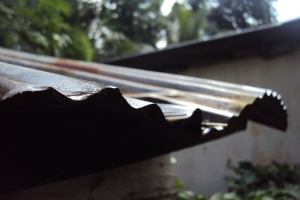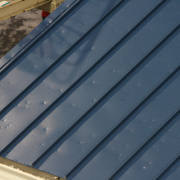Metal Roof Leaking at Ridge
Metal roofing is a great option for both residential and commercial properties because it is a durable, user-friendly, and long lasting material. Whether you are considering a roof extension for your home, or replacing your home or business’ roof entirely with a modern and new metal roof system, there are several benefits to using this material. However, like many other things, there are also a few downfalls when it comes to having a metal roofing system.
Unfortunately, in areas where storms and heavy rain are frequent, there is also a relatively higher chance for your metal roof to start leaking at the ridge. While it may seem like a normal problem that requires a quick fix, metal roof leaking can become quite serious, especially if not attended to as soon as possible. When your metal roof starts leaking at the ridge, you have to take the necessary steps to fixing this problem in order to prevent further damage.

However, before we go on to discuss these important steps, we must first answer the question –
What is the Ridge?
In metal roofing, the ridge refers to the topmost part of the roof. In roofing terms, this refers to the peak of the roof. At this point of the roof, this sis where 2 or maybe even more pieces come together. Usually, this area is covered by a ridge cap to prevent water from seeping into the space between the adjoined pieces. The ridge cap should effectively cover the seams in order to prevent leaking. When there are any signs of leaking right below that area, there is likely a problem with the ridge caps on your metal roof. However, there can also be other reasons for the leak.
Why is the Metal Roof Leaking at Ridge Such a Problem?
Leaking, from any part of a metal roof, is problematic since it can mean that there may be major damage in certain portions of the roof. Aside from just having a hole that requires patching up, a roof leak could bring to question the entire structural integrity of the roof structure. There is always a chance that the water has damaged the interior of the roof.
However, a leak or water infiltration at the ridge, especially if you have a metal roof can be quite problematic. In the first place, it is much harder to discover the primary cause of the leakage. Some of the possible options include improper sealing along the ridge due to loose or damaged ridge caps, faulty installation of the ridge vents, or a problem with the alignment of the metal roof seams. Each of these cases is a possibility, and each one requires a different solution.
Another reason why leaking at the ridge of your metal roof is a problem is because it can take a while to actually notice the leak. This can lead to build-up of mold, mildew, and algal growth over time. And by the time the water actually starts dripping, it will probably be after some major internal damage has been done.
What Can Be Done?
One of the best things that you can do for your metal roof is to prevent leaking in the first place. This can be done by having your roof regularly inspected, preferably by a professional who is familiar with the building codes and regulations of your area. Not only is this essential for maintaining the health of your roof, it is also a great way to spot minor issues before these become major problems that become dangerous and more expensive to repair.
However, if you do find that your metal roof is starting to leak from the ridge, the best step to take is to contact your local roofing contractor. With our expertise at Wade Exteriors, our team will be able to spot the main cause of the leakage, identify the extent of damage, and provide you with the right methods to fixing the problem.
While you might be tempted to get up on your roof yourself and fix you metal roof, we suggest to avoid doing this because it poses a high risk for your safety. When a roof starts leaking, there is a high likelihood that damage has already been done and when you put extra weight on a damaged roof, it may even cave in. Not only is this dangerous, but you end up damaging the entire roof as well as other parts of your home.






